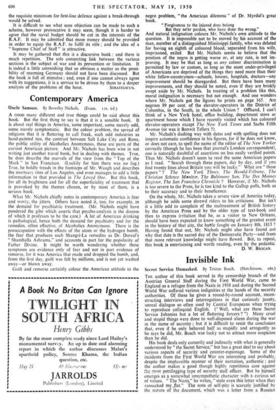Contemporary America
Uncle Samson. By Beverley Nichols. (Evans. 12s. 6d.) A GOOD many different and true things could be said about this book. But the first thing to say is that it is a sensible book. It is about real things in America, some important, some merely odd, some merely symptomatic. But the colour problem, the spread of religions that it is flattering to call freak, such odd industries as hand-painted ties, the contrast between Salt Lake City and Reno, the public utility of Alcoholics Anonymous, these are parts of the current American picture. And Mr. Nichols has been wise in not writing just another travel book, but in dealing with themes. True, he does describe the marvels of the view from the "Top of the Mark " in San Francisco. (Luckily for him there was no fog.) True, he boldly treads in the footsteps of Mr. Waugh and describes the mortuary rites of Los Angeles, and even manages to add a little information to that provided in The Loved One. But this book, for all its brightness and for all the superficiality of treatment that is provoked by the themes chosen, or by most of them, is a serious book.
What Mr. Nichols chiefly notes in contemporary America is fear and worry, the jitters. Others have noted it, too, for example, in the demand for psychiatric treatment. (Mr. Nichols might have pondered the gibe which asserts that psycho-analysis is the disease of which it professes to be the cure,) A lot of American drinking is pathological, hence both the demaInd for psychiatry and for the remedies, often effective, of Alcoholics Anonymous. There is the preoccupation with the effects of the atom or the hydrogen bomb, the fear that produces such Shangri-La remedies as Dr. Doreal's " Shamballa Ashrama," and accounts in part for the popularity of Father Divine. It might be worth wondering whether these symptoms are evidence only of fear and not in part evidence of remorse, for it was America that made and dropped the bomb, and, from the first day, guilt was felt by millions, and is not yet washed away—or blown away.
Guilt and remorse certainly colour the American attitude to the negro problem, " the American dilemma " of Dr. Myrdal's great book.
" Forgiveness to the injured does belong But they ne'er pardon, who have done the wrong."
And natural indignation colours Mr. Nichols's own attitude to the question. It is impossible not to be moved by his account of the man, member of a distinguished Mississippi family, who was delated for having an eighth of coloured blood, -separated from his wife, imprisoned, exiled. But Mr. Nichols seems to believe that the position of the negro is getting worse or, at any rate, is not im- proving. It may be that as long as any colour discrimination is permitted by law or custom, as long as the most under-privileged of Americans are deprived of the things they need more than their white fellow-countrymen--schools, houses, hospitals, doctors—any improvement should be disregarded. But there have been many improvements, and they should be noted, even if they are briskly swept aside by Mr. Nichols. In treating of a problem like this, moral indignation is necessary but not enough. And one wonders where Mr. Nichols got the figures he prints on page 165. Are negroes 89 per cent. of the elevator-operators in the District of Columbia, in the South, in the whole Union ? Offhand, I can't think of a New York hotel, office building, department store or apartment house which I have recently visited which has coloured elevator-operators except The New York Times and Sachs Fifth Avenue (or was it Bonwit Tellers ?).
Mr. Nichols's dashing way with dates and with spelling does not inspire automatic confidence in his figures, for if he does not know, or does not care, to spell the name of the editor of The New Yorker correctly (though he has been that journal's London correspondent), one is naturally doubtful of assertions on less easily verified points. Thus Mr. Nichols doesn't seem to read the same American papers as I read. " Search through these papers, day by day, and if you find twenty lines about Britain you will be lucky." What are " these papers " ? The New York Times, The Herald-Tribune, The Christian Science Monitor, The Baltimore Sun, The Des Moines Register, The San Francisco Chronicle ? However, if Mr. Nichols is too severe to the Press, he is too kind to the. Gallup polls, both as to their accuracy and to their beneficence.
On the whole, Mr. Nichols takes a severe view of America today, although he adds some shrewd riders to his criticisms. But isn't it a little odd to complain of the maltreatment of British history by the American Press and by the older type of text-book and then to express irritation that he, as a visitor to New Orleans, should have been expected to know something of the greatest event in the history of that city, the battle fought on January 8th, 1815 ? Having found that out, Mr. Nichols might also have found out why that date is the sacred day of the Democratic Party—and from that more relevant knowledge might have flowed. But, to repeat, this book is entertaining and worth reading, even by the pedantic.
D. W. BROGAN.










































 Previous page
Previous page